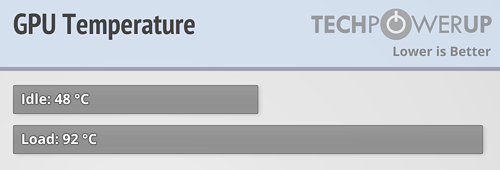 163
163
AMD Radeon RX 5700 XT Review
Overclocking »Temperatures

Overclocked temperatures are not included in the chart above because we changed fan speed and power limit for overclocking, which would make this an unfair comparison.
Just like on other recent AMD cards, the GPU reports a second temperature called "Hot Spot" or "Junction Temperature". While the temperature was at 92°C in the testing above, Hotspot reached 110°C. From what I can tell, the throttle point for Hotspot is set to 115°C in the BIOS.
| GPU Temperature Comparison | |||
|---|---|---|---|
| Idle | Load | Gaming Noise | |
| RX 5700 | 45°C | 79°C | 43 dBA |
| RX 5700 XT | 48°C | 92°C | 43 dBA |
Fan Noise
AMD's Radeon RX 5700 XT lacks the highly popular idle-fan-stop feature, but the idle fan settings are excellent—the card is whisper quiet and pretty much inaudible unless you put your ear right next to it on an open bench.
When gaming, the picture changes completely, though. With 43 dBA, the card is simply noisy. It's slightly quieter than Vega 64, but the levels are pretty much identical to the Vega 56 and Radeon VII. Considering the card is also running fairly hot, I really have to question AMD's choice for their cooling solution.


Jul 12th, 2025 03:28 CDT
change timezone
Latest GPU Drivers
New Forum Posts
- What's your latest tech purchase? (24237)
- What are you playing? (23921)
- Can you guess Which game it is? (226)
- Gigabyte graphic cards - TIM gel SLIPPAGE problem (144)
- [Intel AX1xx/AX2xx/AX4xx/AX16xx/BE2xx/BE17xx] Intel Modded Wi-Fi Driver with Intel® Killer™ Features (367)
- NVIDIA RTX PRO 6000 Workstation Runs Much Hotter Than 5090 FE (22)
- 3D Printer Club (539)
- Will you buy a RTX 5090? (644)
- [GPU-Z Test Build] New Kernel Driver, Everyone: Please Test (89)
- No offense, here are some things that bother me about your understanding of fans. (34)
Popular Reviews
- Fractal Design Epoch RGB TG Review
- Corsair FRAME 5000D RS Review
- Lexar NM1090 Pro 4 TB Review
- NVIDIA GeForce RTX 5050 8 GB Review
- NZXT N9 X870E Review
- Sapphire Radeon RX 9060 XT Pulse OC 16 GB Review - An Excellent Choice
- AMD Ryzen 7 9800X3D Review - The Best Gaming Processor
- Our Visit to the Hunter Super Computer
- Upcoming Hardware Launches 2025 (Updated May 2025)
- Chieftec Iceberg 360 Review
TPU on YouTube
Controversial News Posts
- Intel's Core Ultra 7 265K and 265KF CPUs Dip Below $250 (288)
- Some Intel Nova Lake CPUs Rumored to Challenge AMD's 3D V-Cache in Desktop Gaming (140)
- AMD Radeon RX 9070 XT Gains 9% Performance at 1440p with Latest Driver, Beats RTX 5070 Ti (131)
- NVIDIA Launches GeForce RTX 5050 for Desktops and Laptops, Starts at $249 (119)
- NVIDIA GeForce RTX 5080 SUPER Could Feature 24 GB Memory, Increased Power Limits (115)
- Microsoft Partners with AMD for Next-gen Xbox Hardware (105)
- Intel "Nova Lake‑S" Series: Seven SKUs, Up to 52 Cores and 150 W TDP (100)
- NVIDIA DLSS Transformer Cuts VRAM Usage by 20% (97)
